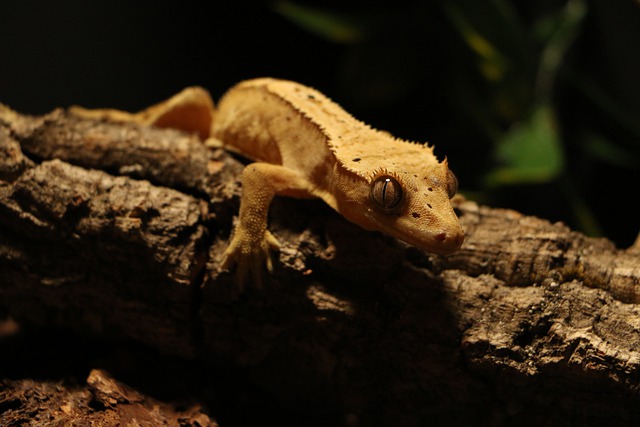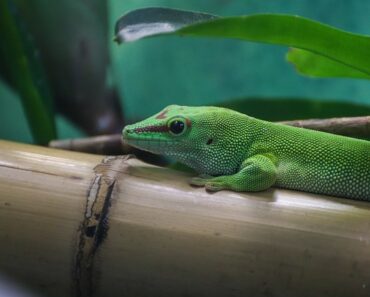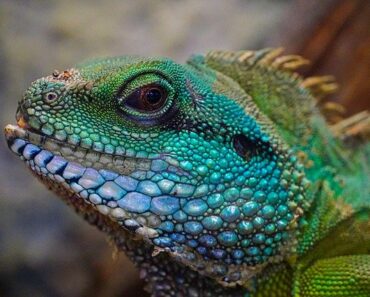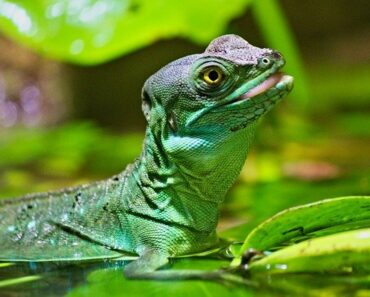Geckos are reptiles of the Saurian family, common in terrariums. Social, easy to breed and reproduce, they are increasingly found as pets.

What is a gecko?
The family Gekkonidae includes about 800 species. Only some of them are available in captivity. Among the most common are :
- The leopard gecko: it is the most common gecko in terrariums. It comes from rocky deserts, in arid regions like Iraq and northern India. The patterns and colors of its coat can be very varied. The different colors are called “phases”. Its particularity is to have mobile eyelids, unlike other geckos whose eyes are covered by a transparent membrane. Moreover, its fingers are not equipped with lamellae, but only with claws. It can measure up to 20 centimeters and, if its breeding conditions are good, live about twenty years.
- The Tokay gecko : it is one of the biggest geckos (about 30 centimeters). It comes from the forests of India and South Asia, and emits a very characteristic cry in two syllables, “to-kay” which is the origin of its name. Its jaws are very powerful and one must be careful with its bites which can be painful. Its body is covered with small orange spots on a bluish-gray background.
- The gold dust gecko: A little smaller than the leopard gecko, this gecko comes from the island of Madagascar. It is a diurnal gecko therefore, its pupil is round and unslit. Its name comes from its green color, yellowish, dotted with small golden points.
- The giant gecko of Madagascar : here is a second day gecko, coming from Madagascar. It can measure between 25 and 30 centimeters. It is traditionally light green in color, darker on the back, with some orange spots in places. However, high red phase geckos have a marked red tint along the back.
Which terrarium for my gecko?
Geckos can live alone, in pairs or in trios, but it is best not to try to get two males to live together, as fights are common.
A small single gecko can be satisfied with a terrarium of 60x30x30 centimeters. A large gecko like the Tokay or the Madagascar Giant might feel a bit cramped, and would surely prefer a terrarium of 80x50x50. As soon as you have several of them, the terrarium will have to be bigger (120x60x60 is ideal).
Sterile sand is a common substrate for leopard gecko. However, its use is controversial because of the risk of intestinal obstruction in case it is ingested. Other substrates are available such as hemp or beech splinters.
For Madagascar geckos a more humid substrate such as peat or potting soil will be preferable. A corner of peat will be necessary in any case if you want your geckos to reproduce. You will need to place hiding places and rocks in the terrarium which will delight leopard geckos, while tree geckos will particularly appreciate the presence of branches.
Like all reptiles, the internal temperature of the gecko is directly dependent on the external environment. Therefore, you will need to provide a heating system that allows the terrarium to reach a warm point of 25 to 30 °C during the day. At night, leopard geckos will be satisfied with 19 to 25°C while Madagascar geckos will appreciate 22 to 24°C. A hygrometry of about 50% is satisfactory for a leopard gecko, but geckos from humid areas need a higher hygrometry (80%).
A priori the UV lamp does not seem to be essential for nocturnal geckos. However, this remains controversial. In the wild, nocturnal geckos receive small amounts of UVB which they are able to use, so the UV lamp is still recommended. A small amount of UVB is enough because nocturnal geckos are very sensitive to it (2%, 6 hours per day). For very light phases, however, UVB is not recommended. For diurnal species, 5% of UVB 12 hours a day is a correct exposure.
What does the gecko eat?
Geckos are easy to feed in captivity. Feeding can be done once a day, or once every other day. You can feed your geckos crickets, locusts, grasshoppers, mealworms or hive moths. It is advisable to sprinkle his food with calcium powder without phosphate because insects are very poor in it.
Vitamin D3 supplementation is controversial. As long as you have a UV lamp, it should be avoided. In their natural environment, some geckos will eat small rodents. So you can occasionally give them mice. Also, Madagascar geckos will eat some fruit.
Finally, clean water should be available at all times, at will.
Gecko reproduction
Geckos are oviparous reptiles, which reproduce very easily in captivity. At the age of one year they are sexually mature, but it is preferable to wait until the female is 18 months old (about 20 centimeters tall) to be sure not to harm her health. Both parents must be in perfect health. The reproduction takes place around February-March.
You can prepare a box of peat or wet vermiculite that you will place in the cold spot of the terrarium, so that the female deposits her eggs, about a month after the mating. There are normally two eggs, but sometimes there is only one.
Once laid, it is preferable to take them, and to place them in an incubator at 80% of humidity. Be careful not to turn them over, they must remain permanently in their initial position to avoid the risk of unhooking the embryo.
The temperature of the incubator influences the sex of the juveniles and the duration of incubation. Eggs incubated at 28 degrees will give females in about 60 days, those incubated at 33 degrees will give males in about 40 days.






